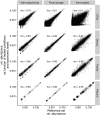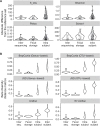Effects of the long-term storage of human fecal microbiota samples collected in RNAlater
- PMID: 30679604
- PMCID: PMC6345939
- DOI: 10.1038/s41598-018-36953-5
Effects of the long-term storage of human fecal microbiota samples collected in RNAlater
Abstract
The adequate storage of fecal samples from clinical trials is crucial if analyses are to be performed later and in long-term studies. However, it is unknown whether the composition of the microbiota is preserved during long-term stool storage (>1 year). We therefore evaluated the influence of long-term storage on the microbiota composition of human stool samples collected in RNAlater and stored for approximately five years at -80 °C. We compared storage effects on stool samples from 24 subjects with the effects of technical variation due to different sequencing runs and biological variation (intra- and inter-subject), in another 101 subjects, based on alpha-diversity, beta-diversity and taxonomic composition. We also evaluated the impact of initial alpha-diversity and fecal microbiota composition on beta-diversity instability upon storage. Overall, long-term stool storage at -80 °C had only limited effects on the microbiota composition of human feces. The magnitude of changes in alpha- and beta- diversity and taxonomic composition after long-term storage was similar to inter-sequencing variation and smaller than biological variation (both intra- and inter-subject). The likelihood of fecal samples being affected by long-term storage correlated with the initial relative abundance of some genera and tend to be affected by initial taxonomic richness.
Conflict of interest statement
The authors declare no competing interests.
Figures






Similar articles
-
Effects of Stool Sample Preservation Methods on Gut Microbiota Biodiversity: New Original Data and Systematic Review with Meta-Analysis.Microbiol Spectr. 2023 Jun 15;11(3):e0429722. doi: 10.1128/spectrum.04297-22. Epub 2023 Apr 24. Microbiol Spectr. 2023. PMID: 37093040 Free PMC article.
-
Assessment of the impact of different fecal storage protocols on the microbiota diversity and composition: a pilot study.BMC Microbiol. 2019 Jun 28;19(1):145. doi: 10.1186/s12866-019-1519-2. BMC Microbiol. 2019. PMID: 31253096 Free PMC article.
-
Collection of non-meconium stool on fecal occult blood cards is an effective method for fecal microbiota studies in infants.Microbiome. 2017 Sep 5;5(1):114. doi: 10.1186/s40168-017-0333-z. Microbiome. 2017. PMID: 28870234 Free PMC article.
-
Collection media and delayed freezing effects on microbial composition of human stool.Microbiome. 2015 Aug 12;3:33. doi: 10.1186/s40168-015-0092-7. eCollection 2015. Microbiome. 2015. PMID: 26269741 Free PMC article.
-
From-Toilet-to-Freezer: A Review on Requirements for an Automatic Protocol to Collect and Store Human Fecal Samples for Research Purposes.Biomedicines. 2023 Sep 28;11(10):2658. doi: 10.3390/biomedicines11102658. Biomedicines. 2023. PMID: 37893032 Free PMC article. Review.
Cited by
-
Chronic Rhinosinusitis-Microbiological Etiology, Potential Genetic Markers, and Diagnosis.Int J Mol Sci. 2024 Mar 11;25(6):3201. doi: 10.3390/ijms25063201. Int J Mol Sci. 2024. PMID: 38542175 Free PMC article. Review.
-
Compositional Changes in the Gut Microbiota of Responders and Non-responders to Probiotic Treatment Among Patients With Diarrhea-predominant Irritable Bowel Syndrome: A Post Hoc Analysis of a Randomized Clinical Trial.J Neurogastroenterol Motil. 2022 Oct 30;28(4):642-654. doi: 10.5056/jnm21202. J Neurogastroenterol Motil. 2022. PMID: 36250371 Free PMC article.
-
Sex-Specific Associations between Gut Microbiome and Non-Alcoholic Fatty Liver Disease among Urban Chinese Adults.Microorganisms. 2021 Oct 8;9(10):2118. doi: 10.3390/microorganisms9102118. Microorganisms. 2021. PMID: 34683439 Free PMC article.
-
Role of gut microbiota in epigenetic regulation of colorectal Cancer.Biochim Biophys Acta Rev Cancer. 2021 Jan;1875(1):188490. doi: 10.1016/j.bbcan.2020.188490. Epub 2020 Dec 13. Biochim Biophys Acta Rev Cancer. 2021. PMID: 33321173 Free PMC article. Review.
-
Effects of storage conditions on the microbiota of fecal samples collected from dairy cattle.PLoS One. 2024 Aug 9;19(8):e0308571. doi: 10.1371/journal.pone.0308571. eCollection 2024. PLoS One. 2024. PMID: 39121104 Free PMC article.
References
Publication types
MeSH terms
Substances
LinkOut - more resources
Full Text Sources
Medical

